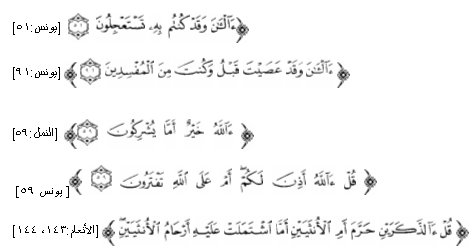Hamzah Al-Wasl

Lesson 8
The Meeting of a hamzah qata' and hamzah wasl in one
word
Continuation of: Case 2 The Questioning hamzah al-qata'
preceding hamzah al-wasl
In Nouns
When a hamzah qata’
( )
indicating a question )
)
indicating a question ) )
enters a noun that has the definite article "alif laam at-ta'reef"
)
enters a noun that has the definite article "alif laam at-ta'reef"
 attached at the
beginning of it, the hamzah wasl is undergoes changes, so that the questioning
hamzah can be distinguished from the hamzah wasl of the alif laam at-ta'reef.
Without a change in the hamzah al-wasl, it would be impossible to determine
whether there was a question before the
attached at the
beginning of it, the hamzah wasl is undergoes changes, so that the questioning
hamzah can be distinguished from the hamzah wasl of the alif laam at-ta'reef.
Without a change in the hamzah al-wasl, it would be impossible to determine
whether there was a question before the
 or not, since we
begin nouns that have
or not, since we
begin nouns that have
 in front of them
with a fat-h and the
in front of them
with a fat-h and the  of
questioning also begins with a fat-h. The hamzah wasl would normally not be
pronounced at all during continuous reading. When this questioning hamzah
qata’ is present before a noun starting with
of
questioning also begins with a fat-h. The hamzah wasl would normally not be
pronounced at all during continuous reading. When this questioning hamzah
qata’ is present before a noun starting with
 , the hamzah al-wasl
is changed either one of the two following states. Both of these ways of
recitation are allowed in the recitation of
, the hamzah al-wasl
is changed either one of the two following states. Both of these ways of
recitation are allowed in the recitation of

(Hafs 'an 'Aasim min tareeq Ash-Shaatibiyyah).
1.
A lengthened alif
–This is called  (ibdaal)
(ibdaal)
2.
An “eased”
hamzah-This is called  (tas-heel)
(tas-heel)
The first way:

Its definition:
When a hamzah indicating a
question ( )
enters a noun that has the definite article
"
)
enters a noun that has the definite article
" "
, the hamzah al-wasl of
"
, the hamzah al-wasl of
 is changed into an
lengthened alif which is lengthened six counts. This
lengthening is six vowel counts due to the sukoon on the lam after the
long alif. The medd is
is changed into an
lengthened alif which is lengthened six counts. This
lengthening is six vowel counts due to the sukoon on the lam after the
long alif. The medd is  and is
either "heavy" (
and is
either "heavy" ( ) when followed by a shaddah, or "light (
) when followed by a shaddah, or "light ( )
when there is a simple sukoon after the long alif.
)
when there is a simple sukoon after the long alif.
The second way:
When a hamzah
indicating a question ( ) enters a noun that has the definite article
) enters a noun that has the definite article
 the hamzah al-wasl,
the hamzah al-wasl,
 is pronounced but “eased” so that it is between a hamzah and an alif, with
absolutely no medd.
is pronounced but “eased” so that it is between a hamzah and an alif, with
absolutely no medd.
Occurrences:
This lengthening occurs in three words in six places in the Qur’an.
The three words are:


The aayaat in which
this occurs in are as follows:

To listen to the word,
 with
ibdaal, (
with
ibdaal, ( ) click here.
) click here.
To listen to the word,
 with
tas-heel (
with
tas-heel ( )
click here.
)
click here.
A reminder, all of these three words
in the six different aayaat shown above can be read with either
 or
or
 ,
the two different examples are just examples of two different words each read
a different way; these same words can be read the other way, in the way we
read: Hafs 'an 'Aasim min tareeq Ash-Shaatibiyyah.
,
the two different examples are just examples of two different words each read
a different way; these same words can be read the other way, in the way we
read: Hafs 'an 'Aasim min tareeq Ash-Shaatibiyyah.
Repeating again, the
reason for the need of the hamzah wasl to be used, but changed, is that
without the questioning hamzah, the word would be started with a fat-h on the
hamzah al-wasl. The questioning hamzah qata' has a fat-h on it, and without
using and changing the hamzah wasl, the listener would not be aware that there
was a question. This is because the word would sound the same with or without
the question hamzah qata' if there was no change in the hamzah wasl.